A few decades ago it was “consensus” science that CO2 levels had reached 400 ppm (and even up to 500 ppm) during the Early Holocene, with rising amplitudes of greater than 200 ppm and rates of 65 ppm in less than a century. Then the “consensus” opinion changed.
In 1982 it was still quite acceptable for Dr. Flohn, a climate scientist, to acknowledge that changes in CO2 concentration changes are significantly determined by temperature “rather independent of” fossil fuel emissions, but also that Holocene CO2 concentrations reached 350 to 400 ppm between 8,000 to 6,000 years ago (Flohn, 1982).
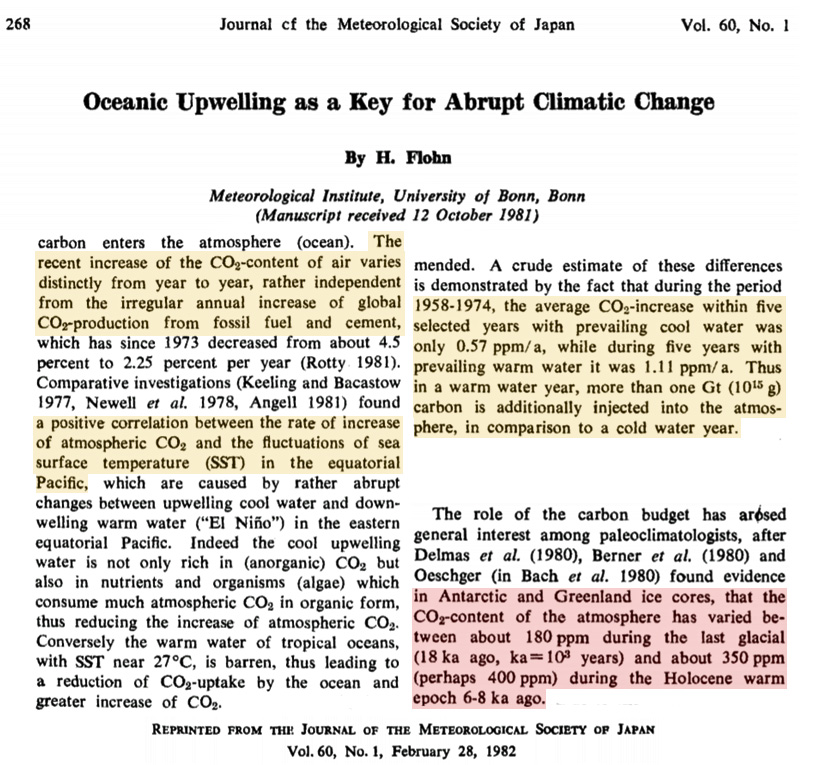
That same year, Neftel et al. (1982) had published a paper in the journal Nature documenting a CO2 rise of about 230 ppm (~190 ppm to 420 ppm) from roughly 12,000 to 10,000 years ago for a Greenland ice core. The CO2 record showed fluctuations of >100 ppm throughout the Holocene.
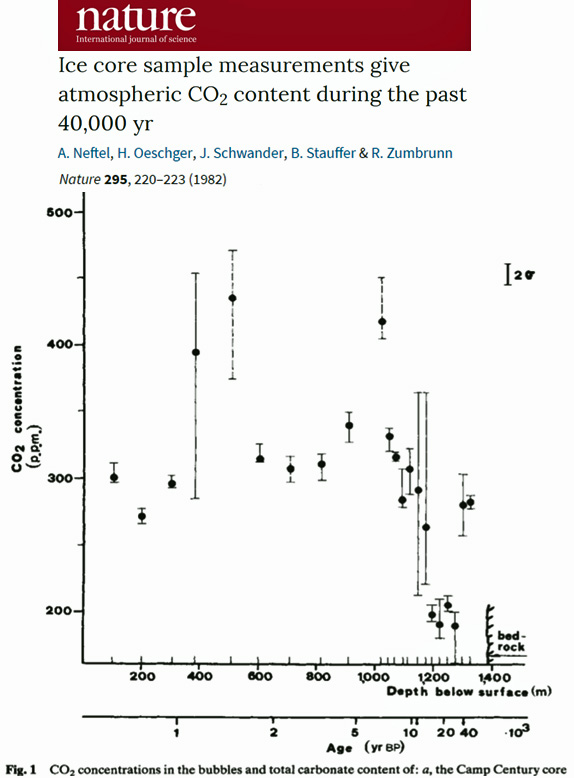
A few years earlier, Berner et al. (1980) found CO2 rose to amplitudes exceeding 500 ppm in Greenland during the Early Holocene, whereas Antarctica’s CO2 concentration rose to about 400 ppm during the same time period.
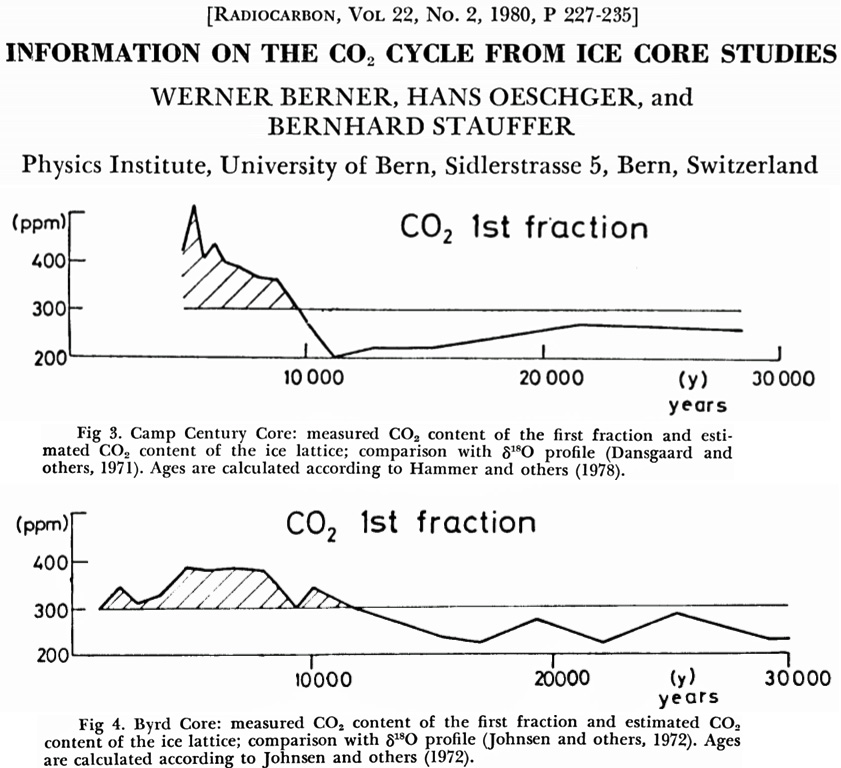
As late as 1993 scientists were still publishing papers on CO2 readings from ice cores that ranged between 243.3, 435.7 ppm, and 641.4 ppm for recent centuries (Schwander et al., 1993).
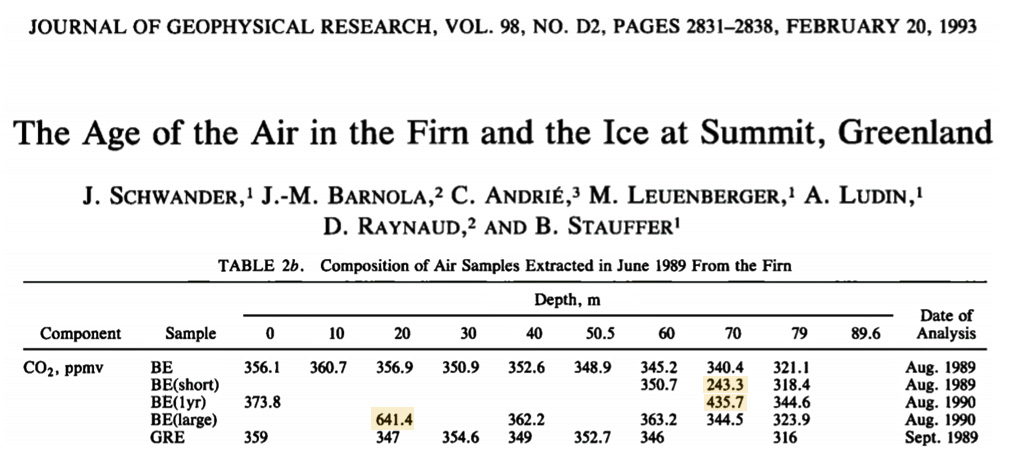
Wagner et al. (1999) published a paper in Science denouncing the “consensus” claim that CO2 gently and steadily rose for millennia, varying only beteen 270 to 280 ppm. They too determined CO2 rose and fell quite rapidly during the Holocene, reaching amplitudes of 65 ppm in less than a century.
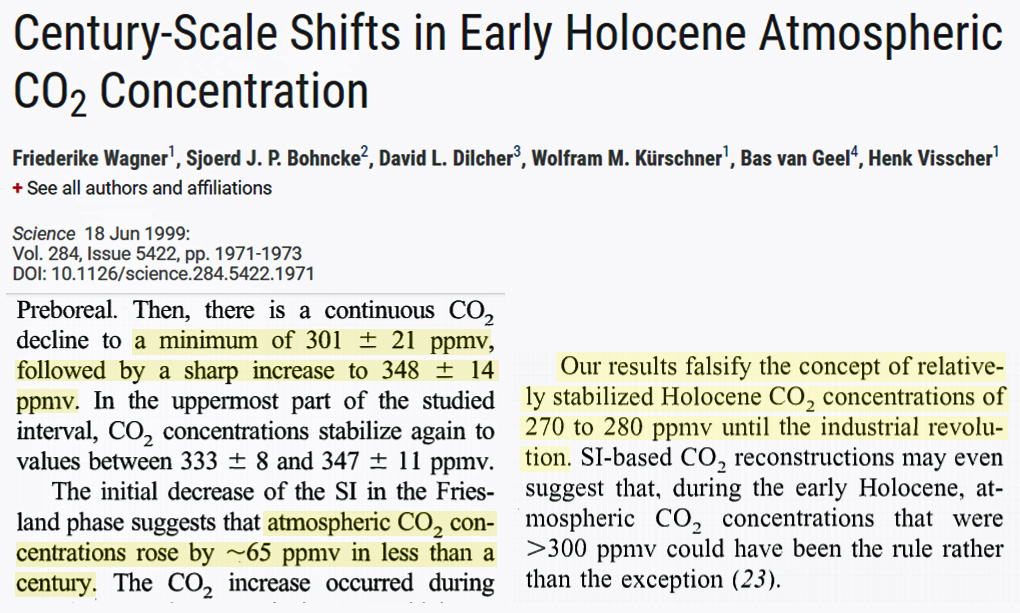
More recent papers also indicate there were quite substantial ±100 ppm-per-century CO2 fluctuations in stomata reconstructions. Steinthorsdottir et al., 2013 record a rise of about 190 ppm (from ~230 ppm to ~420 ppm) within less than 50 years.
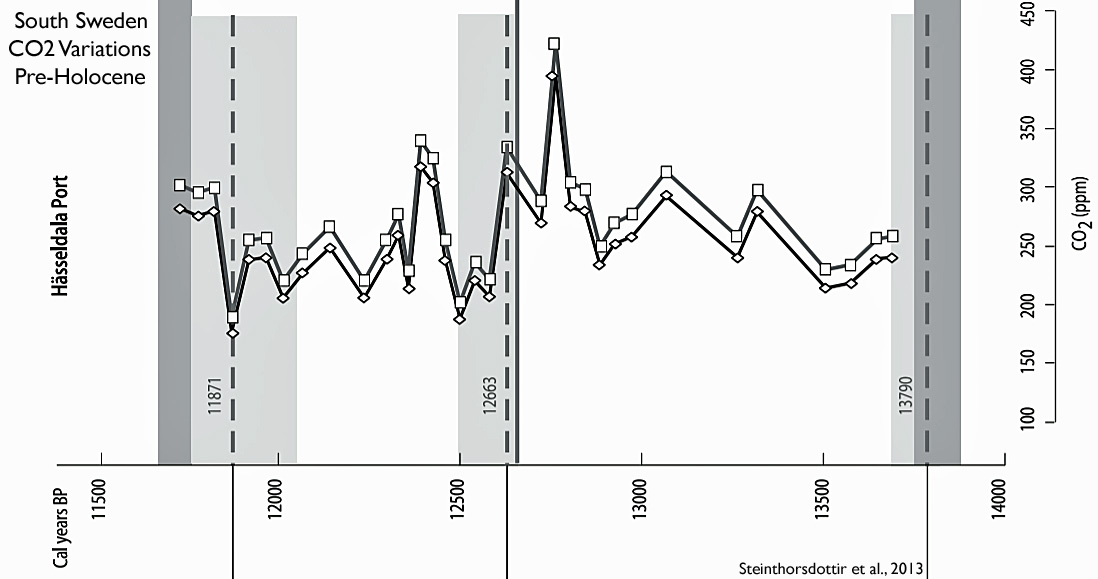
Stomatal reconstructions of 800-2000 A.D. CO2 variability (Kouwenberg et al., 2005) determined there was a ~125 ppm CO2 rise from 1850 (250 ppm) to 1940 (375 ppm).
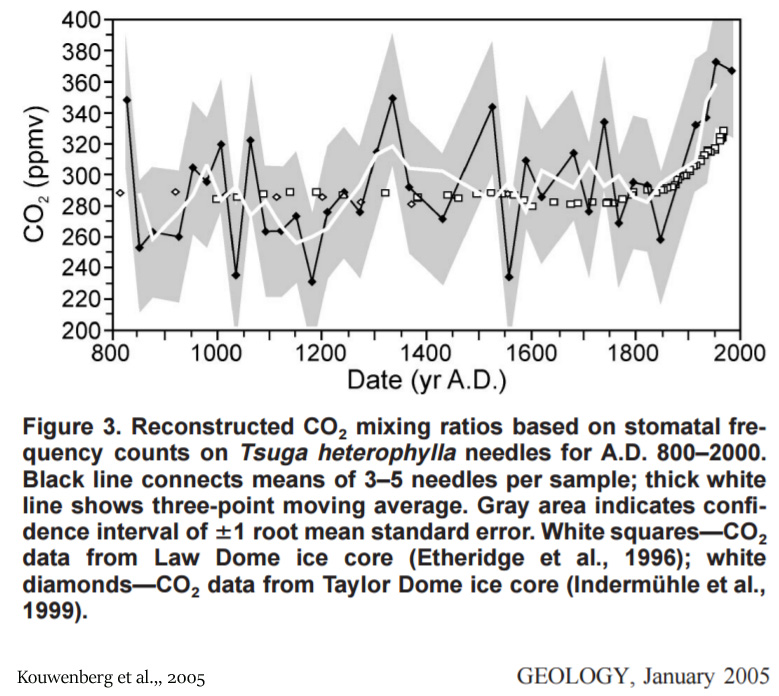
Why the discrepancy between “consensus” CO2 and historically recorded CO2?
Polish physicist Dr. Zbigniew Jaworowski (1997) was a fierce critic of the means by which ice core data have been collected to assign CO2 concentration values to past epochs.
His criticisms center around the post-1985 tendencies for fellow scientists to openly employ selection bias in making pre-determined decisions about what measurements are “right” and which ones are “wrong” – effectively rendering their results meaningless.
He cites Pearlman et al. (1986), for example. These authors collected 74 Antarctic ice core CO2 samples. Of those, 32 (43%) were rejected because they had values that were too high or too low to match with the agreed-upon pre-determination.
In what other branch of science is it acceptable to discard measured data we don’t agree with?

Jaworowski provides an illustrative example of how the rejecting-data-we-don’t-agree-with practice has been ongoing since the 1950s.
G.S. Callendar’s CO2 measurements reached 375 to 550 ppm throughout the 1800s. These measurements were believed to be too high. So Callendar chose the measurements that he agreed with (circled).
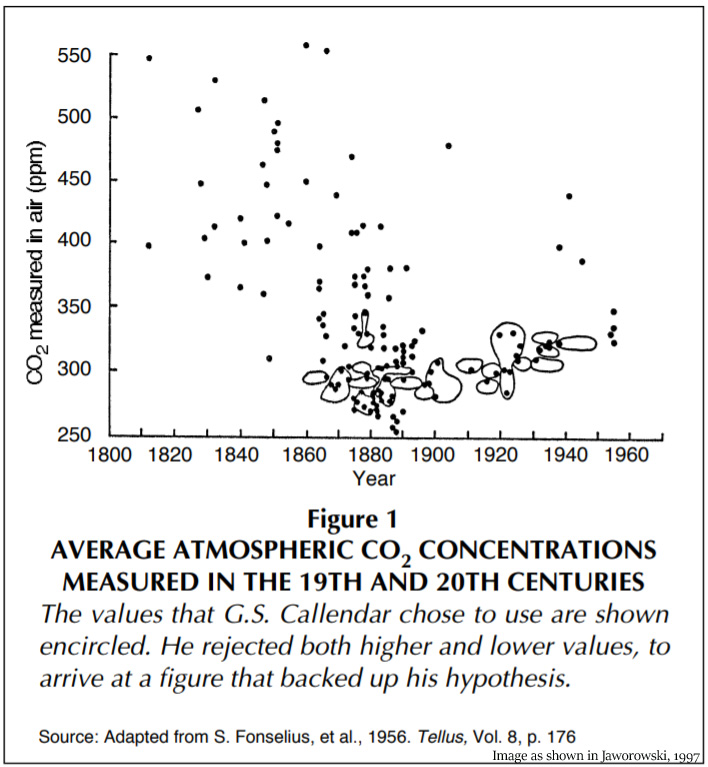
Professor Tom Segalstad, a University of Oslo geologist, provides possibly the most thorough explanation of how the current CO2 “dogma” was formulated and maintained so as to advance the CO2 greenhouse warming cause.
Segalstad (1998) concludes:
“It is shown that carbon cycle modelling based on non-equilibrium models, remote from observed reality and chemical laws, made to fit non-representative data through the use of non-linear correction ‘buffer’ factors constructed from a pre-conceived hypothesis, constitute a circular argument and with no scientific validity.”
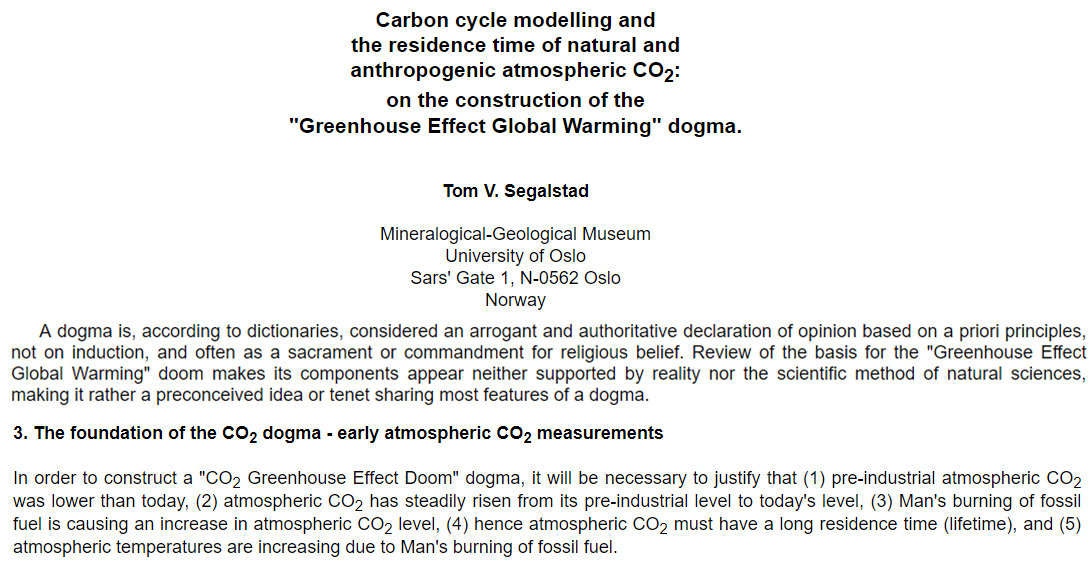





“In what other branch of science is it acceptable to discard measured data we don’t agree with?”
When there are not only no consequences for deception, but one is even rewarded for it, you will find it almost anywhere.
[…] A few decades ago it was “consensus” science that CO2 levels had reached 400 ppm (and even up to 500 ppm) during the Early Holocene, with rising amplitudes of greater than 200 ppm and rates of 65 ppm in less than a century. Then the “consensus” opinion changed. In 1982 it was still quite acceptable for Dr. Flohn, a climate scientist, to acknowledge that changes in CO2 concentration changes are significantly determined by temperature “rather independent of” fossil fuel emissions, but also that Holocene CO2 concentrations reached 350 to 400 ppm between 8,000 to 6,000 years ago (Flohn, 1982). (Source) […]
Only two other responses. This is a great find. thank you.
Jaworwski and Segalstad challenged the false narrative on CO2 that was created from ice cores and other substitutes for atmospheric data. Their challenge has now been confirmed in what really matters: Real data of atmospheric CO2, which is free of the huge uncertainties surrounding those reconstructions, uncertainties that were exploited to produce the false narrative. Real atmospheric data has now shown irrefutably, in several recent analyses, that man’s emissions of CO2 are much too small to be responsible for the observed increase of CO2. Everything else is academic.
https://youtu.be/b1cGqL9y548
https://notrickszone.com/2019/07/03/new-study-in-journal-of-earth-sciences-human-activities-not-responsible-for-observed-co2-increase/
http://www.sciencepublishinggroup.com/journal/paperinfo?journalid=298&doi=10.11648/j.ijaos.20190301.13
This recent research invalidates the very premise of the IPCC. Because of its importance, NTZ should feature the new research to promote its exposure to the public and to those responsible for public policy. The IPCC sure won’t.
This find explains why we don’t have a history of CO2 going up and down with heat, that history has been edited out as an outlier.
This complements the findings you cite.
Academic fraud isn’t all that academic.
Obviously Henry’s Law was working then; warmer oceans releasing dissolved CO2 gas.
Fortunately for a number (a large number) of “scientists” on government grants it turns out that Henry’s law was repealed by the IPCC in 1993.
Even more fortunately (for them) it turns out that laws giving them money cannot be repealed, even queried.
This is heresy! Burn the witches!
Circles around the desired CO2 concentrations looks more like detective work and hardly science.
Where are the arrows? If you have circles, you must also use arrows.
Oh, another inaccurate climate denier study. What a surprise.
Old Ice from Greenland (and surrounding areas like sweden) contains excess CO2 that it attained from meltwater in this area (as CO2 is very soluble in water). That’s why they don’t really use much of the data and considered the extremely high values in accurate.
Measured data that do not fit the narrative are discarded. Measured data that do fit the narrative are retained. It’s called confirmation bias, and it’s not science.
And if there isn’t sufficient measured data to make their case, they simply make it up.
https://realclimatescience.com/2017/02/nasa-noaa-climate-data-is-fake-data/
Another instance of “fixing” “bad” data, an impossibility in the real world.
https://wattsupwiththat.com/2017/01/28/homogenization-of-temperature-data-makes-capetown-south-africa-have-a-warmer-climate-record/
Roy Spencer stumbles on their fraud (see also link to his site there).
https://dailycaller.com/2015/03/09/more-evidence-of-climate-data-tampering-by-noaa/
ASIDE – Judging from his writing, could it be that Greg Martini is composing under the, …hic, …influence of too many Martinettis? //;–0]
I would pose following question:
Is the Antarctic representative of the ‘global’ temperature record ?
Is the Atmospheric CO2 value global ?
Why would the ‘global’ CO2 value correlate with the antarctic temperature the way it is claimed ?
Why are measurments published from ice cores not taken at equidistance ?
[…] https://notrickszone.com/2019/07/22/1980s-science-ice-cores-show-co2-naturally-rose-200-ppm-65-ppm-1… […]
[…] https://notrickszone.com/2019/07/22/1980s-science-ice-cores-show-co2-naturally-rose-200-ppm-65-ppm-1… […]
[…] https://notrickszone.com/2019/07/22/1980s-science-ice-cores-show-co2-naturally-rose-200-ppm-65-ppm-1… […]